Abstract
For the multi-energy power system composed of thermal power, wind power, and a pumped-storage power station aiming at minimizing coal consumption of the power grid, an optimal dispatch model is established in this paper. Its advantage is to allow the power grid to accept a high proportion of new energy while ensuring power demand. The dynamic programming method is used to solve the problem. In the solution process, the traditional dynamic programming method is improved by introducing the penalty function and the dynamic value of the state variable, which can ensure the reliability of the power supply while achieving the optimization goal, as well as realize the full utilization of energy. Using the example of a high proportion of wind power systems with a pumped-storage power station as the energy storage mode and considering the relevant constraints after the heating transformation of the thermal power plant, our built model solves these challenges. The results show that when the maximum pumping power of the pumped-storage power station reaches 1138 MW and the maximum generating power reaches 755 MW, the wind curtailment and power rationing during the off-peak period of heating can be reduced from the previous 58,158 MWH and 46,838 MWH to almost 0, and the wind curtailment and power rationing during the peak period of heating can be reduced from the previous 77,656 MWH and 53,780 MWH to almost 0, so as to realize the flexible operation of the power grid.
1. Introduction
With global warming, reducing emissions of greenhouse gases such as carbon dioxide is increasingly urgent. The power industry creates large carbon emissions, making it a key industry for carbon dioxide emission reduction. The European roadmap for the power sector dictates that an 80–95% cut of existing levels of carbon dioxide emissions is needed by the year 2050 to meet climate goals [1,2,3]. As a power generation source with almost zero carbon emissions, new energy power generation has developed rapidly in recent years. However, new energy power generation based on solar and wind resources has low reliability and strong variability and intermittency [4]. In many cases, the output does not match the load demand, and thus the high proportion of new energy power will greatly increase the difficulty of grid power balance at many times. Determining how to use energy storage methods such as pumped storage to coordinate and stabilize the fluctuations of new energy sources, accept as many new energy sources as possible under the premise of safe and stable operation, and achieve the lowest carbon dioxide emissions are the major challenges of the current power grid. Facing the problem of the high rate of abandoning new energy, it is necessary to allocate a certain amount of energy storage to promote wind power consumption and stabilize power grid operation [5]. In reference [6], electric boilers are used as energy storage technology to match the fast fluctuation of wind power. In reference [7], the storage battery is used to consume wind power and photovoltaic power. In reference [8], a thermal-electric decoupling (TED) approach is proposed to both bring down the constraint of forced power output of combined heat and power plants and increase the electric load level during valley load times that assist the power grid in consuming more wind power. At present, many researchers use different methods to solve the problem of economic load dispatching (ELD) of the power grid. For example, reference [9] used a novel evolutionary algorithm of hybrid multi-agent particle swarm optimization (HMAPSO) to solve the economic load distribution (ELD) problem considering transmission losses, and the results show that the calculation time of this method is relatively uniform and short. Reference [10] proposes an artificial ecosystem optimization (AEO) algorithm. AEO is a population-based optimizer that is stimulated by the flow of energy into the earth’s ecosystem to solve the problem of economic load scheduling (ELD). The results show that AEO has robustness, appropriateness, and effectiveness in terms of computation time and approaching the global optimal solution. Reference [11] proposes a multi-objective optimization algorithm based on a genetic algorithm to economically dispatch thermal power and reduce the emitted polluting gases and production costs while generating electricity.
In general, most of the algorithms used in the current power system load economic dispatch are new artificial intelligence algorithms. These algorithms often have fast calculation speeds, high efficiency for some systems, and can learn by themselves, but they often fall into local optimal solutions, accumulated errors can deteriorate the final result, and the accuracy is not very high; some parameters need to be adjusted repeatedly during the operation for manual guidance [12,13,14]. For a power system with a limited number of power plants, the operation accuracy requirement is high, while the overall time complexity is not high. For this type of system, it is difficult to obtain the optimal solution by using the above calculation method, and because of the limited data, the space for self-learning is also very small. Reference [15] applied the dynamic programming method and the genetic algorithm together to the Qingming project for comparison. Experiments show that the dynamic programming method is much faster than the genetic algorithm when the number of power plants in the system is less than eight (small-scale system), and the genetic algorithm cannot guarantee the optimal solution. The model studied in this paper is the power grid, which dispatches the power plants rather than the units. Therefore, this paper defines the small-scale system as the number of power plants in the system is less than eight. In view of this, this paper considers using dynamic programming. Dynamic programming can obtain the global optimal solution, greatly reduce the amount of calculation, and can use experience to improve the solution efficiency and calculation accuracy. Dynamic programming has also been used in reactive power distribution, voltage adjustment, and power flow distribution in power systems. For example, reference [16] studied the 380 kV grid in the Western Operating Area (SEC-WOA) of Saudi Electricity Company to determine the reactive power compensation capacity. Compared with the Genetic Algorithm (GA) and the Hybrid Genetic Algorithm (HGA), dynamic programming showed a better solution. Reference [17] shows that the dynamic programming method can locate a globally optimal reactive power distribution under the condition of normal operation of the micro-grid.
In addition, dynamic programming can also add corresponding strategies based on experience and actual needs. In the flood control scheduling of reservoirs, the improved DP is constructed according to the principle of period inflow and water balance, which includes a variable dispersion mechanism of the retraction space and a calculation method for the smallest discrete points of each discrete range [18]. Reference [19] adds a heuristic search method to the dynamic programming solution for grid voltage optimization. Reference [20] adds a random search algorithm to the dynamic programming solution to determine the correct value of the shunt capacitor and transformer load tap changer. This paper will improve the dynamic programming solution, adding a penalty function to the dynamic programming recursion equation and making the final state variables dynamic so as to give full play to the advantages of dynamic programming and realize the multi-objective economic operation and dispatch of the power grid.
In this paper, a power grid composed of wind power, thermal power, and pumped-storage power stations will be used as an example. Aiming at the minimum coal consumption, an optimal dispatch model for the multi-energy power system is established, using dynamic programming to solve the model and obtain the final optimization plan. When deriving the recurrence equation in dynamic programming, the equation is a superposition of coal consumption and the penalty function. The penalty function is included mainly to add the corresponding penalty value to the recursive equation according to the power rationing and wind curtailment of the power grid, so as to reduce the power rationing and wind curtailment of the power grid according to the actual situation in the dynamic programming solution, making the operation of the grid low-carbon and more reliable. After the dynamic programming and solution, the operation scheme under the goal of minimum coal consumption can be obtained. The scheme considers various constraints and gives some reference for the power grid while ensuring various constraints. Under this scheme, the pumped-storage power station exerts its peak regulation capability as much as possible, complements wind power, and greatly reduces the unreliability of wind power. In actual operation, power grids and power plants in different regions have different constraints. The model established in this paper considers the actual situation and can be applied to other power grids dispatching according to the actual situation to provide other power grids with low-carbon and reliable operation solutions.
2. Modeling of Power System Dispatching Operation
2.1. Objective Function
(1) Environmental benefits are very important for the grid. When the coal consumption in the system is the smallest and the corresponding carbon emission is also the smallest, the environmental benefits of the system are the best [21]. Therefore, the first goal in this paper is to minimize the coal consumption of the system.
In the formula, B is the total coal consumption, indicating the coal consumption when the output of the thermal power unit is , and is 15 min (the dispatching requirements of the power system), which is the length of a period.
(2) The large power rationing will have a great impact on the development of society. Therefore, for the power supply of the grid, the power rationing must be as little as possible so that the social development has a stable power supply. When the power grid is running, the power rationing should be the minimum (the second goal)
In the formula, is the load demand of the grid, is the actual output of wind power, is the output of thermal power, is the pumping power of the pumped-storage power station, and is the power generated by the pumped-storage power station. is the sum of power rationing. Power rationing will only occur when the actual demand is greater than the power capacity of the grid.
(3) Wind power is a clean energy source, and it does not generate additional carbon emissions in the process of power generation. Therefore, the power grid should accept wind power as much as possible and try not to curtail the wind power. Therefore, the system also needs to minimize the amount of wind curtailment (the third goal).
In the formula, indicates the sum of wind curtailment, and is the maximum output capacity of wind power in period i.
(4) The thermal unit is related to urban heating. When the output of the thermal unit varies greatly, the temperature of urban heating fluctuates greatly. From the perspective of urban heating, the output of the thermal power unit should be kept as constant as possible (the fourth goal).
In the formula, indicates the output fluctuation value of the thermal power unit, and indicates the average output of the thermal power unit.
In the modeling and analysis, a certain initial and final state quantity are selected first, and goal 1 is first achieved according to the constraints so as to minimize the total coal consumption. In the dynamic programming solution, the final energy storage value of the pumped-storage power station is changed, and the penalty function is also introduced according to the wind curtailment and power rationing. In this way, goals 2 and 3 can be achieved, and the minimum amount of wind curtailment and power rationing can be realized. After getting the results, it can be manually corrected according to the actual situation to achieve goal 4 so that the output of the thermal unit remains stable. The realization process of multiple goals is shown in Figure 1.
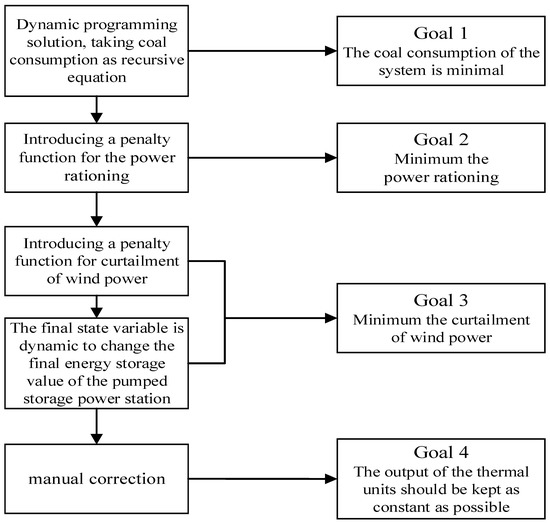
Figure 1.
The realization of multiple goals.
2.2. Constraints
In the model, constraints are divided into system power balance constraints, thermal power, wind power, and pumped-storage power output constraints.
2.2.1. System Power Balance Constraint
The system power balance constraint is mainly the load balancing constraint:
In the formula, is the grid load demand, not the real-time power supply of the grid. is the actual output of wind power, is the thermal power, is the pumping power of the pumped-storage power station, and is the power generated by the pumped-storage power station. The is used because the power supply from the grid can be less than the demand but cannot greater than the demand.
2.2.2. Thermal Power Constraints
Due to the limitation of heating and operating conditions, the output of the thermal power plant can only fluctuate within a range, and the rate of change will also be greatly constrained [22].
(1) The constraints of thermal power output range are:
In the formula, is the lower output limit of the thermal power plant and is the output upper limit of the thermal power plant.
(2) The constraints of thermal power output change rate:
In the formula, UR and DR are the rate limits for the uphill and downhill ramps of the thermal power plant. is the output of the thermal power plant in period i.
2.2.3. Constraints of Pumped-Storage Power Station
(1) Constraints of pump working conditions of the pumped-storage station:
In the formula, is the lower limit of the output under the working condition of pumping, is the upper limit of the output under the working condition of pumping.
(2) Turbine working condition limitations of the pumped-storage station:
In the formula, is the lower limit of the output under the generating condition, and is the upper limit of the output under the generating condition.
(3) The constraints of reservoir capacity of pumped-storage power station:
In the formula, is the amount of water storage in the reservoir, and is the maximum water storage allowed by the reservoir.
(4) Constraints on the energy storage value of pumped-storage power stations:
In the formula, is the amount of energy stored in the reservoir. is the maximum energy storage value allowed by the reservoir, and it is related to water head and . The energy stored in the reservoir can be calculated by the following formula:
In the formula, is the generator efficiency, taken as 0.88 here. is the efficiency of the pump working condition, taken as 0.90 here.
(5) Constraints on working conditions of pumped-storage power plants:
Due to the limitations of the water conservancy facilities of the pumped-storage power station, the power station cannot generate electricity and pump water at the same time.
2.2.4. Wind Power Output Constraints
Because the output of wind power is affected by the weather and is constrained by wind energy resources at a certain time, the output of wind power has an upper limit, which is . Wind power can be curtailed but cannot generate electricity beyond the upper limit.
3. Dynamic Programming Algorithm for Solving the Model
3.1. Introduction to Dynamic Programming Algorithm
Dynamic programming is a method used in mathematics, computer science, and economics to solve complex problems by breaking the original problem into relatively simple sub-problems. Dynamic programming is often suitable for problems with overlapping sub-problems and optimal substructure properties, and the time consumption of dynamic programming methods is often much less than that of naive solutions. The basic idea behind dynamic programming is very simple. Roughly speaking, to solve a given problem, solve its different parts (sub-problems), and then combine the solutions of the sub-problems to arrive at the solution of the original problem. Often, many sub-problems are very similar, and for this reason, dynamic programming attempts to solve each sub-problem only once, thus reducing the amount of computation: once the solution of a given sub-problem has been solved, it is memorized so that it is feasible to check the table directly when solving the same sub-problem next time. This practice is particularly useful when the number of repeated sub-problems grows exponentially with the size of the input.
Solving steps:
- (1)
- Stage division: According to the characteristics of the problem, the problem is divided into several stages. The divided stages must be ordered or sortable.
- (2)
- Determining the state and state variables: Reflect the various situations in which the problem develops to various stages. The choice of the state must satisfy no follow-up.
- (3)
- Determine the decision and write the state transition equation: The state transition means to derive the state of this stage according to the decision and state of the previous stage. The decision-making method and state transition equation are determined according to the relationship between the states of two adjacent stages.
- (4)
- Boundary conditions: the state transition equation is a recursive formula, so it is necessary to find the conditions for the termination of the recurrence.
3.2. Improvement Strategies for Dynamic Programming
- (1)
- The dynamic value of the final state variable
In the traditional dynamic programming method, the initial and final states are fixed values for carrying out the optimization solution. However, many factors need to be considered in the power grid dispatching. In this paper, the energy storage value of the pumped-storage power station was selected as the state variable. In reality, the economic and stable operation of the power grid must be considered. In order to consider the extreme situation of the power grid operation, the model assumes that the energy storage value of the pumped-storage power station is 0 at the start so that the power grid will not experience more serious power outages during normal operation.
When considering the final state of the state variable, its value is not necessarily 0 in this paper. Because the energy stored in the pumped-storage power station can be reused later, if the final state variable value is forced to be 0, the wind power may be curtailed in some periods while the power grid can use this part of the wind power later, which causes the waste of wind energy resources. Therefore, when solving the model, this paper sets different final state variable values and calculates the minimum value B (the coal consumption) of the power grid in each case. Then, the power supply of the power grid and the stored energy of the pumped-storage power station are calculated, and the total available power can also be calculated according to the following formula.
Next, divide the coal consumption B of the power grid by the total available power to obtain the coal consumption b per unit of electricity consumption of the power grid.
Compare the coal consumption b per unit of electricity consumption in different states and find the minimum value corresponding to this value, which is the real economic operation point of the power grid.
- (2)
- Add penalty function
When solving the model, according to the traditional dynamic programming, the recursive equation should be the coal consumption of the thermal power plant . However, the loss caused by the power rationing of the power grid is very large, which should be avoided as much as possible during the operation of the power grid. Therefore, in order to minimize the power rationing of the grid, the penalty function method is introduced during the solution, which is to set a penalty factor and a penalty function. Then, the penalty function is added to the recursion equation so that the penalty factor can be used to greatly reduce the amount of electricity that is curtailed. The role of the penalty function is very significant. For example, in reference [23], the penalty function is used to realize peak shaving and valley filling and balance the energy distribution of the power system.
3.3. The Steps of the Calculation
- (1)
- Separate the calculation period; divide the scheduling period (15 days) into 1440 periods, every 15 min for one session.
- (2)
- Determine the state transition equation as:
- (3)
- Determine the dynamic programming recursion equation as:
Among them, is the recursive equation, which means the sum of coal consumption and penalty function value from period i to the end of calculation period when the water storage capacity is , according to the optimal operation mode. is the penalty factor for power rationing, and is the sum of power rationing in period i. is the penalty factor for wind curtailment and power rationing, and is the sum of wind curtailment in period i.
- (4)
- Determine the solution method.
When solving the point i, select the reachable point i + 1 at first. For the reachable point, the corresponding thermal power output must be within a positive or negative range of its corresponding output and must meet other constraints. For the point i + 1 that it can reach, calculate the coal consumption from point i + 1 to it, as well as the amount of wind curtailment and the power rationing of the grid, then calculate the distance between the two points, so as to use the recursive equation to calculate the total distance from the point to the last point. Calculate the total distance of all paths from the point to the last point, and then the shortest path and the shortest distance corresponding to the point can be obtained.
- (5)
- Starting from the last point, calculate the distance to the initial point according to the above process four, find the shortest path from the initial point to the last point, and calculate the corresponding distance.
- (6)
- Change the value of the final state, repeat the above five calculation processes. After calculating the power which can be supplied by the power grid , calculate the coal consumption of unit power supply b according to b = B/. Establish the relationship between the final state value and the coal consumption b per unit of power supply and find the corresponding final state value when the coal consumption per unit of power supply is the lowest.
- (7)
- The final state value corresponding to the above 1–6 is the economic operation point of the power grid, and the optimal path is also found according to the initial and final state values of the power grid. According to the optimal path, the optimal output curve of thermal power and the output curve of the pumped-storage power station are obtained, and the wind power output curve is determined according to the operating state of the pumped-storage power station. Calculate the coal consumption of the power grid, the power available for the power grid, the wind curtailment, and the power rationing of the power grid.
- (8)
- According to the calculation results, check the rationality of the data and make certain adjustments. If it is still unsatisfactory for power rationing or the wind curtailment power, increase the value of the penalty factor and recalculate.
- (9)
- Finally, make manual correction according to the actual situation to keep the thermal power output as stable as possible.
The detailed steps of dynamic programming are as follows (Figure 2).
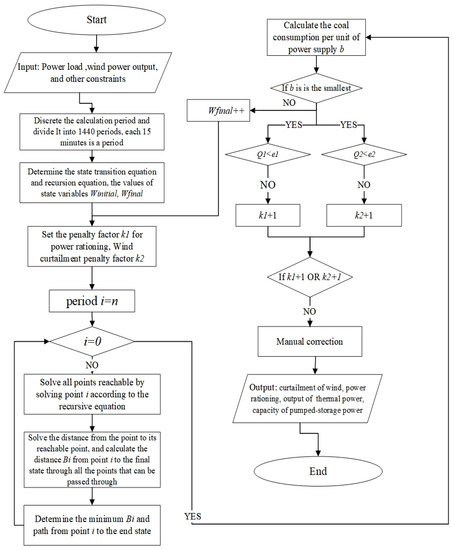
Figure 2.
The steps of dynamic programming.
4. Case Study
4.1. Introduction to the Power System
(1) There is a thermal power plant running in the power grid of a certain place. The installed capacity of the first phase of the power plant is 2 × 135 MW, and the installed capacity of the second phase is 2 × 330 MW. Previously, the city was powered by this power plant. In recent years, the city is trying to build a green and environmentally friendly city. Due to the early construction time and low efficiency of the first phase of the plant, the city decides to shut down the first-phase units. At the same time, the second phase of the power plant is reformed for heating, and the coal-fired heating boiler is shut down.
(2) In order to save energy and reduce emissions, the city transforms the second-phase units into cogeneration units, using the waste heat generated by the power plant to heat the city, which greatly improves the efficiency of the power station and reduces carbon emissions. At present, the heating area is 15.88 million square meters, and the energy saving effect is remarkable. However, after the transformation of the cogeneration unit, in order to ensure the normal heating of the city and the safety of the pipeline, the adjustability of the unit is greatly reduced. Table 1 shows the heating situation of the second-phase units of the power plant after heating transformation, and Table 2 shows the output constraints during heating.

Table 1.
The heating situation of the thermal power plant.

Table 2.
The output constraints during heating.
The relationship between coal consumption and the output of each thermal power unit is:
In the formula, a = 0.525, b = 55.41, c = 468.2, B is coal consumption(kg/h), and p is the output of a unit (MW).
(3) The city is very rich in wind energy resources, and the city vigorously develops wind power generation. At present, the installed capacity of wind power has reached 1350 MW. The output of wind power is very unstable with intermittent, random characteristics. The output of wind power varies greatly, which requires great reliability of the power grid.
(4) The following Figure 3 shows the 15-day electricity load curve and wind power output curve of the power grid. As can be seen from the figure, the volatility of wind power is very strong, and the output of wind power and the load power of the grid are seriously mismatched, so that the goal of accepting a high proportion of wind power in the grid cannot be achieved by relying on traditional energy sources.
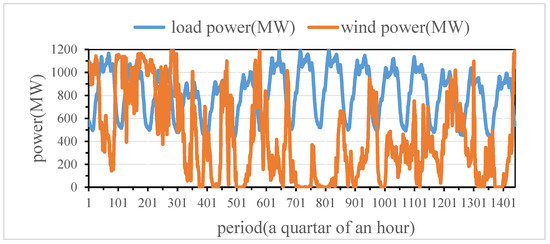
Figure 3.
Power load and wind power output.
(5) In order to solve the problem of large installed capacity of wind power in the city, strong output variability, the low adjustability of cogeneration units, and urban heating’s strict restrictions on the output of cogeneration units, it is decided to lease a pumped-storage power station in another system to achieve the goal of the combined operation of thermal power, wind power, and pumped-storage power.
(6) The pumped-storage power station is a cascade hybrid pumped-storage power station. The pumped-storage power station is built by using the reservoirs of two cascade hydropower stations in a certain basin by building new reversible units and underground powerhouses. At present, the remaining 4*300 MW reversible hydraulic turbines can be rented. The upper reservoir is an annual regulating reservoir with a normal storage level of 710 m, a dead water level of 690 m, and an average water level of 700 m. Considering the scheduling of the upper reservoir, the available power generation storage capacity of the pumped-storage power station is 36.6 million m3. The lower reservoir is a daily-regulating reservoir, and the water level is kept at 310 m during normal operation. The pumped-storage power station currently allows a maximum energy storage value of 38,857 MWH.
4.2. Results and Analysis
4.2.1. The Off-Peak Period of Heating
- (1)
- Pumped-storage power station not involved in operation
When the city temperature is not very low, the combined thermal power unit is in the operation state of the off-peak period of heating.
It can be seen from Figure 4 that if there is no pumped-storage power station in operation, wind curtailment and power rationing will be severe. According to numerical calculation, at this time, the power rationing is 46,834.76 MWH, accounting for 3.99% of the total demand, and the wind curtailment reaches 58,518.275 MWH, accounting for 39.17% of the total wind power generation capacity. On the one hand, the reliability of the power grid is insufficient, and on the other hand, a large amount of clean energy is wasted.
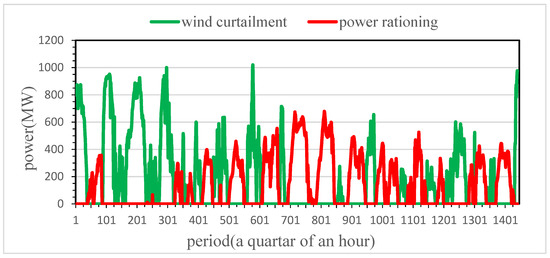
Figure 4.
The situation of wind curtailment and power rationing without the pumped-storage power station during an off-peak period of heating.
- (2)
- Pumped-storage power station involved in operation
①. The operation of pumped-storage power
Figure 5 shows the output of the pumped-storage power station and the energy stored in reservoir, which is the operation of the pumped-storage power station during the off-peak period of heating.
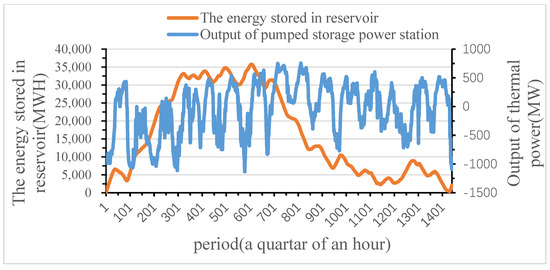
Figure 5.
Operation of pumped-storage power station in heating off-peak period.
②. The load composition
As shown in Figure 6, the output of the thermal power plant was relatively stable at this time, and the average output of the thermal power plant was 444 MW. During the period of off-peak heating, the pumped-storage power station operates jointly with wind power, absorbing wind power and participating in the peak regulation of the power grid, which plays an important role in the stable operation of the heat network and the efficient operation of the thermal power plant.
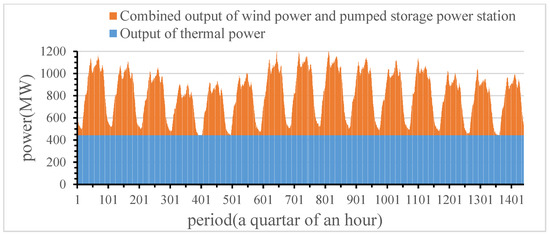
Figure 6.
The load composition in heating off-peak period.
③. The capacity of the pumped-storage power station
As shown in Figure 7, when the pumped-storage power station is running while the output of the thermal power plant is stable and the power rationing of the grid is 0, the maximum output of the pumped-storage power station under the power generation condition should be reached at 755 MW, and if the wind curtailment of the grid is 0, the maximum pumping power of the station is 1132 MW. If there is no wind curtailment or power rationing, the pumped-storage power station should have a capacity of 1132 MW.
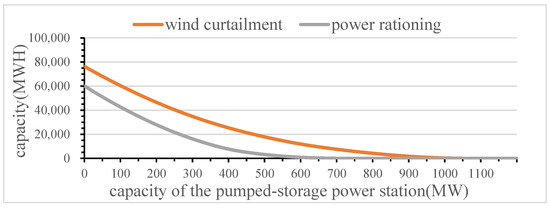
Figure 7.
Input capacity and curtailment of wind and power rationing in the off-peak period of heating.
4.2.2. The Peak Period of Heating
When the temperature of the city is low, the combined heat and power unit is operating in the peak heating period.
(1) Pumped-storage power station not involved in operation
As can be seen from Figure 8, if there is no pumped-storage power station in operation, the wind curtailment and power rationing during the heating peak period are also severe. According to the numerical calculation, at such a time, the power rationing of the grid was 53,780.53 MWH, accounting for 4.60% of the total demand (3.99% in the heating off-peak period), and the wind curtailment reached 77,656.323 MWH, accounting for 51.99% of the total wind power generation (heating peak period 39.17%); the power operation at this time was more severe than the heating peak period.
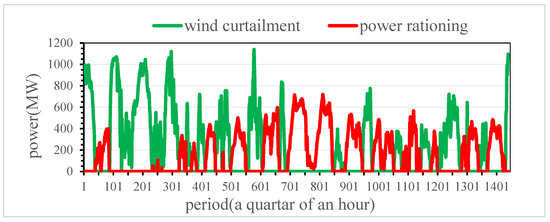
Figure 8.
The situation of wind curtailment and power rationing without pumped-storage power station during peak period of heating.
(2) Pumped-storage power station involved in operation
①. The operation of pumped-storage power
Figure 9 shows the output of pumped-storage power station and the energy stored in reservoir, which is the operation of pumped-storage power station during peak period of heating.
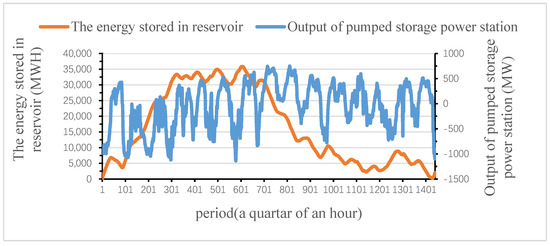
Figure 9.
Operation of pumped-storage power station in heating peak period.
②. The load composition
Figure 10 shows the composition of the load during heating peak period. As shown in Figure 10, after the pumped-storage power station participates in operation, the output of the thermal power plant is relatively stable, with an average output of 450 MW.
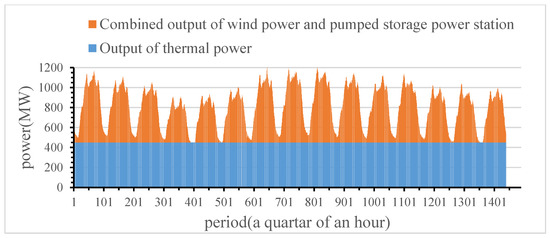
Figure 10.
The load composition in heating peak period.
③. The capacity of the pumped-storage power station
As shown in Figure 11, when the pumped-storage power station is running while the output of the thermal power plant is stable, and the power rationing of the system is 0, the maximum output of the pumped-storage power station under the power generation condition should reach 750 MW. In addition, if the wind curtailment of the system is 0, the maximum pumping power of the pump is 1138 MW. Only when the input capacity of the pumped-storage power station is greater than or equal to 1138 MW can the grid be free from wind curtailment and power rationing.
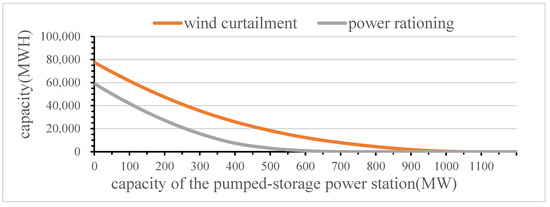
Figure 11.
Input capacity and curtailment of wind, power rationing in the peak period of heating.
4.2.3. Statistical Analysis
Algorithms for Solving the Models
Reference [15] has demonstrated that for small-scale systems (less than eight power plants in the system), dynamic programming has advantages in speed and accuracy. In order to verify the accuracy of the improved dynamic programming algorithm, the model was solved by using the improved dynamic programming algorithm and the unimproved dynamic programming algorithm, and then compared the obtained results. The comparison results were mainly the wind curtailment and power rationing during the peak period of heating and the off-peak period of heating.
It can be seen from Table 3 that when the pumped-storage power station is put into the same capacity, the improved dynamic programming algorithm can minimize the wind curtailment and power rationing, while the unimproved dynamic programming algorithm cannot simultaneously minimize the wind curtailment and power rationing. This reflects that when solving multi-objective problems, making the value of final state variable dynamic and adding penalty function are indeed huge improvements to the dynamic programming algorithm. In addition, the improved dynamic programming algorithm shows achievability in solving the model and is feasible. By exploring the results of reference [14] and whether to improve dynamic programming, this paper believes that for this small-scale system (the number of power plants in the system is less than eight), the algorithm is feasible compared to other existing algorithms, and the results obtained are also accurate.

Table 3.
Related indicators for unimproved and improved dynamic programming.
The Models
It can be clearly seen from the Table 4 that when there is no pumped-storage power station to participate in the operation of the power grid, both the wind curtailment and the power rationing account for a large proportion. If it is in the peak period of heating, the proportion of abandoned wind power will reach nearly 52%, and the power limit will account for 4.6%. At this time, not only a large amount of clean wind power is wasted, but the normal power supply of the city cannot be satisfied. When the pumped-storage power station is added to the power grid, whose maximum pumping power of the pumped-storage power station reaches 1138 MW and maximum pumping power reaches 755 MW, the wind curtailment and the power rationing of the grid can be reduced to 0, which makes wind power an important power source for the power grid. In addition, the output of the thermal power plant is very stable, which ensures the safety of urban heating. This proves that the model proposed in this paper can improve the ability of the grid to accept new energy under the condition of ensuring the power demand and meeting various constraints.

Table 4.
Quantitative analysis.
However, the utilization rate of the units of the pumped-storage power station under different working conditions is extremely unbalanced. If wind power is to be fully consumed, more capacity needs to be invested. If the rental cost of the pumped-storage power station is high, the wind curtailment can be reduced to improve the utilization rate of pumped-storage power and ensure the economic operation.
5. Conclusions
Increasing the use of renewable energy sources is one of the strategic objectives of the European Union. In this paper, an optimal dispatch model of the multi-energy power system is established, and dynamic programming is used to solve the low-carbon operation scheme of the power grid. Aiming at the shortcomings of the dynamic programming method, the penalty function and the dynamic method of state variables are introduced, which are used in the solution process of dynamic programming. Through case study, the following conclusions can be obtained:
(1) Aiming at the minimum coal consumption of the power grid, this paper established an optimal dispatch model of the multi-energy power system, which is composed of thermal power, wind power, and a pumped-storage power station. Through the demonstration of case study, the model could coordinate the output of various energy sources in the system, especially solving the high proportion problem of wind power consumption, and it had a good promotion and application value.
(2) The dynamic programming method is used to solve the model in this paper. We found that for small-scale systems (the number of power plants in the system is less than eight), the process of dynamic programming is fast and can obtain the global optimal solution, and it can complete the multi-goal solution according to the actual situation. The solution considers the actual operation of the power grid, which not only fully absorbs new energy power, but also fully guarantees the power demand and achieves a win–win situation. This shows that the improved dynamic programming algorithm is feasible in solving multi-objective problems, and the obtained results are also accurate.
(3) Through the above analysis of the case study, it is evident that the pumped-storage power station is an effective means to promote the absorption of new energy. When the number of power plants in the system is less than eight, this model can be solved with the improved algorithm to determine the appropriate capacity of the pumped-storage power station, absorbing the high proportion of wind power while ensuring power demand.
(4) In addition, through calculation, it is found that during operation, the penalty factor of wind curtailment and power rationing can be adjusted according to the situation, so as to realize the economical operation of the power grid.
Author Contributions
Investigation, writing—original draft, Z.L.; writing—review & editing, J.M.; Methodology, Z.J. All authors have read and agreed to the published version of the manuscript.
Funding
This study was financially supported by the Natural Science Foundation of China (52179016), Natural Science Foundation of Hubei Province (2021CFB597).
Data Availability Statement
If there is a need for research, readers can obtain relevant data through the mailbox of the corresponding author.
Acknowledgments
The authors are grateful to the anonymous reviewers for their comments and valuable suggestions.
Conflicts of Interest
The authors declare no conflict of interest.
References
- Kacperska, E.; Łukasiewicz, K.; Pietrzak, P. Use of Renewable Energy Sources in the European Union and the Visegrad Group Countries—Results of Cluster Analysis. Energies 2021, 14, 5680. [Google Scholar] [CrossRef]
- Norwood, Z.; Goop, J.; Odenberger, M. The Future of the European Electricity Grid Is Bright: Cost Minimizing Optimization Shows Solar with Storage as Dominant Technologies to Meet European Emissions Targets to 2050. Energies 2017, 10, 2080. [Google Scholar] [CrossRef]
- Karoly, N.; Krisztina, K. Use of renewable energy sources in light of the “New Energy Strategy for Europe 2011–2020”. Appl. Energy 2012, 96, 393–399. [Google Scholar]
- Calif, R.; Schmitt, F.; Duran, O.M. −5/3 Kolmogorov turbulent behavior and Intermittent Sustainable Energies. In Sustainable Energy; Zobaa, A., Abdel Aleem, S., Afifi, S.N., Eds.; Intech: London, UK, 2016. [Google Scholar] [CrossRef]
- Xiao, B.; Xing, S.; Wang, T.; Yang, Y.; Dong, L.; Yang, H.; Lu, G. Capacity Planning of Pumped Storage Power Station Based on the Life Cycle Cost. Electr. Power Compon. Syst. 2020, 48, 1263–1271. [Google Scholar] [CrossRef]
- Han, X.; Wang, F.; Tian, C.; Xue, K.; Zhang, J. Economic Evaluation of Actively Consuming Wind Power for an Integrated Energy System Based on Game Theory. Energies 2018, 11, 1476. [Google Scholar] [CrossRef]
- Shavolkin, O.; Shvedchykova, I.; Kolcun, M.; Medved’, D. Improvement of the Grid-Tied Solar-Wind System with a Storage Battery for the Self-Consumption of a Local Object. Energies 2022, 15, 5114. [Google Scholar] [CrossRef]
- Rong, S.; Li, W.; Li, Z.; Sun, Y.; Zheng, T. Optimal Allocation of Thermal-Electric Decoupling Systems Based on the National Economy by an Improved Conjugate Gradient Method. Energies 2016, 9, 17. [Google Scholar] [CrossRef]
- Suganyadevi, M.V.; Danila Shirly, A.R. Optimization of Power Generation Costs Through Soft Computing Techniques. In Proceedings of the Advances in Electrical and Computer Technologies: Select Proceedings of ICAECT 2021, Coimbatore, India, 1–2 October 2021; Springer Nature: Singapore, 2022; pp. 901–913. [Google Scholar]
- Bhattacharjee, K.; Shah, K.; Soni, J. Solving Economic Dispatch using Artificial Eco System-based Optimization. Electr. Power Compon. Syst. 2022, 49, 1034–1051. [Google Scholar] [CrossRef]
- Mehdi, N.; Sadegh, H.; Mohammad, H. Planned production of thermal units for reducing the emissions and costs using the improved NSGA II method. Case Stud. Therm. Eng. 2019, 13, 100397. [Google Scholar]
- German, G. Global optimization strategies for implementing 3D common-reflection-surface stack using the very fast simulated annealing algorithm: Application to real land data. Geophysics 2018, 83, V253–V261. [Google Scholar]
- Mohammed, E.; Mohamed, E. An Adaptive Hybrid Approach: Combining Neural Networks and Simulated Annealing to Calculate the Equilibrium Point in Max-stable Problem. IAENG Int. J. Comput. Sci. 2021, 48, 893–898. [Google Scholar]
- Luokai, H.; Jin, L.; Chao, L.; Fuchuan, N.; Hang, C. A Phoenix++ Based New Genetic Algorithm Involving Mechanism of Simulated Annealing. Int. J. Distrib. Sens. Netw. 2015, 2015, 806708. [Google Scholar]
- Xiang, L.; Yang, J.; Zhou, J.; Zhou, T. The comparison between dynamic programming and genetic algorithm in the Qinjiang Project. Hydropower 2003, 9, 65–67. [Google Scholar]
- Mobarak, Y.; Dessuki, M.E. Reactive power compensation of Saudi electricity-western operation area using dynamic programming and genetic algorithm. J. Electr. Syst. 2019, 15, 30–41. [Google Scholar]
- Yoash, L.; Yuval, B.; Liran, K.; Josep, M. Real-time reactive power distribution in microgrids by dynamic programing. IET Gener. Transm. Distrib. 2017, 11, 530–539. [Google Scholar]
- Wang, S.; Jiang, Z.; Liu, Y. Dimensionality Reduction Method of Dynamic Programming under Hourly Scale and Its Application in Optimal Scheduling of Reservoir Flood Control. Energies 2022, 15, 676. [Google Scholar] [CrossRef]
- Jeong, K.; Chung, J. Optimal Voltage and Reactive Power Scheduling for Saving Electric Charges using Dynamic Programming with a Heuristic Search Approach. J. Electr. Eng. Technol. 2016, 11, 329–337. [Google Scholar] [CrossRef]
- Eugene, F.; Jiaqiao, H.; Eting, Y. A stochastic search algorithm for voltage and reactive power control with switching costs and ZIP load model. Electr. Power Syst. Res. 2016, 133, 328–337. [Google Scholar]
- Zhang, Y.; Zhang, F.; Li, Y.; Mo, J.; Tang, L. Analysis on Optimal Mode of Operation of Small and Medium Pumped Storage Power Station. IOP Conf. Ser. Earth Environ. Sci. 2021, 680, 012032. [Google Scholar] [CrossRef]
- Dai, L.; Wang, M. Study on the influence of carbon emission constraints on the performance of thermal power enterprises. Environ. Sci. Pollut. Res. Int. 2020, 27, 30875–30884. [Google Scholar] [CrossRef]
- Tao, L.; Gao, Y.; Liu, Y.; Zhu, H. A rolling penalty function algorithm of real-time pricing for smart microgrids based on bilevel programming. Eng. Optim. 2019, 52, 1295–1312. [Google Scholar] [CrossRef]
Publisher’s Note: MDPI stays neutral with regard to jurisdictional claims in published maps and institutional affiliations. |
© 2022 by the authors. Licensee MDPI, Basel, Switzerland. This article is an open access article distributed under the terms and conditions of the Creative Commons Attribution (CC BY) license (https://creativecommons.org/licenses/by/4.0/).